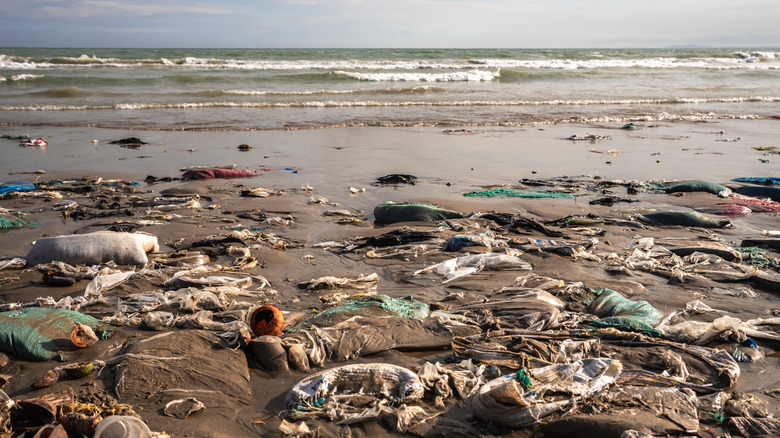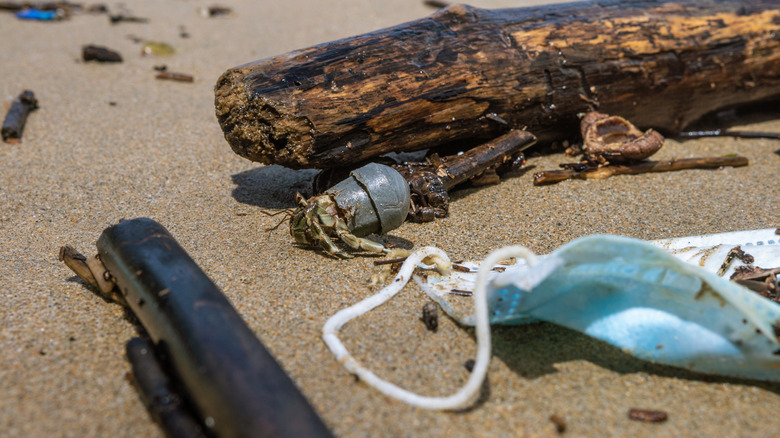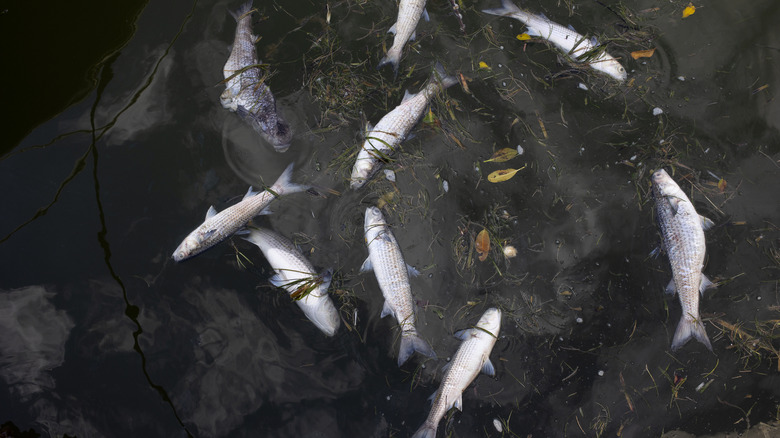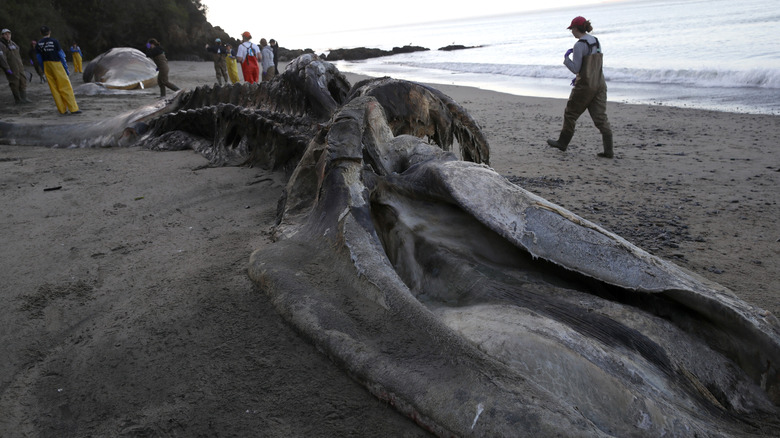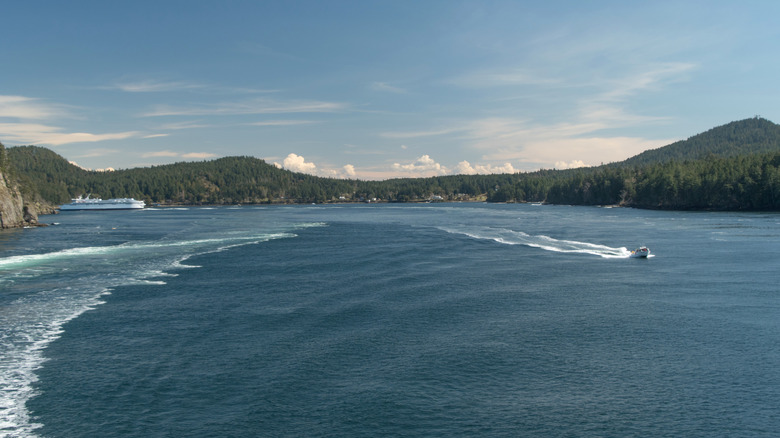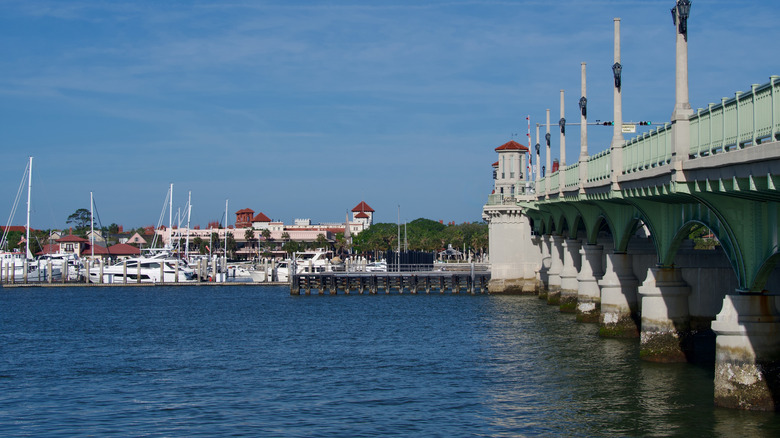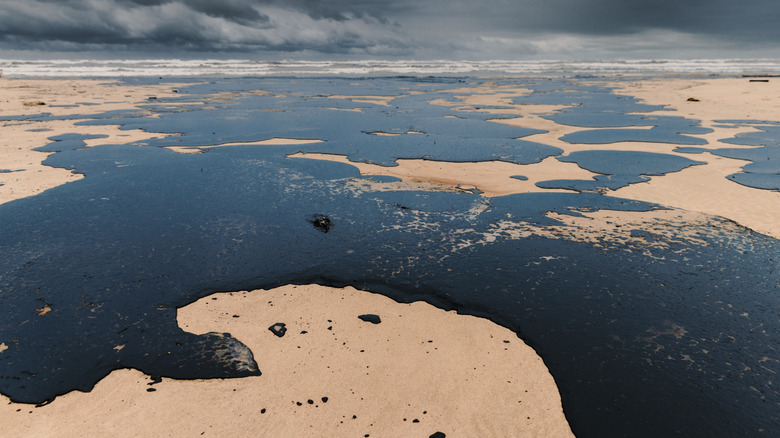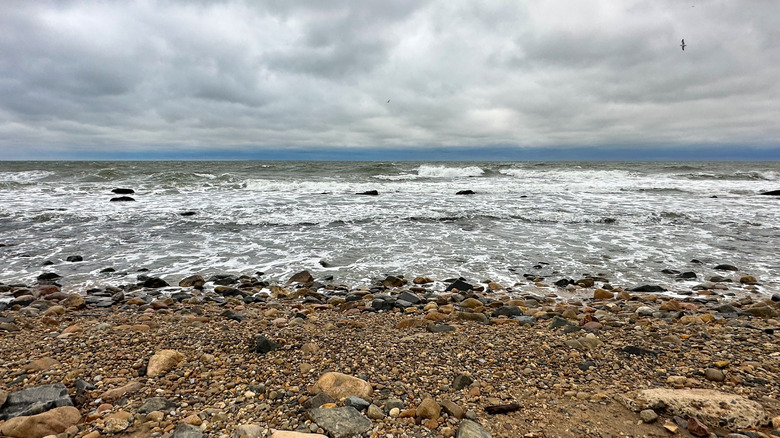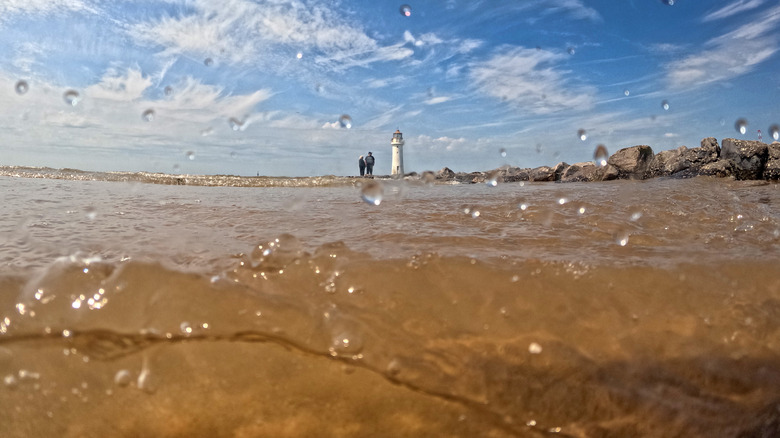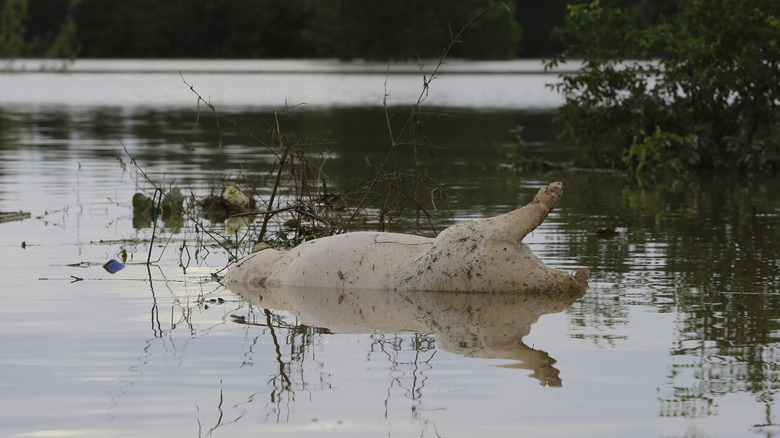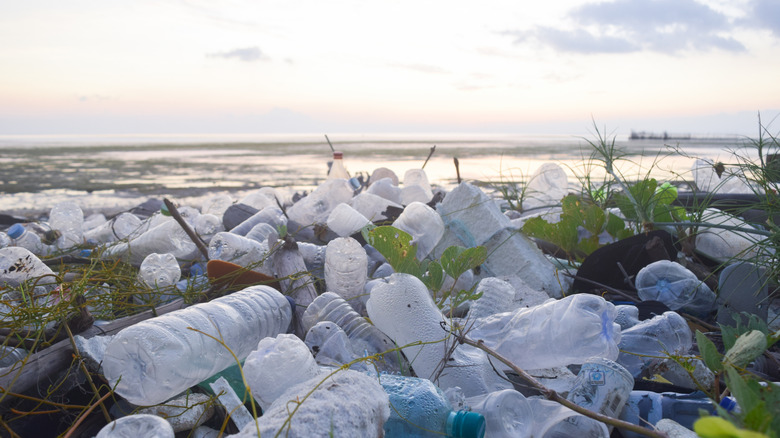10 Grossest Things Ever Found At Beaches
For most of us, hearing the word "beach" conjures images of "toes in the water" and "cold drink in my hand." But anyone who has spent too much time near the shoreline knows that beaches can also be a wildly unpredictable dumping ground for some pretty gross things. Sometimes the waves bring in treasures, and other times, they deliver beach finds that would've been better left to the depths. From decomposing sea creatures that baffle scientists to oil spill remnants that are still hanging around a decade later, it's not always fun and games at the beach. It's not all nature's fault, either. Human negligence, from faulty plumbing systems to murder in the first degree, has left its mark on coastlines around the world in a variety of unforgettable — and, frankly, unpleasant — ways.
This list rounds up 10 of the grossest things ever found on beaches, though, ironically, none of them were found on any of the filthiest beaches in America. We'll journey from the downright bizarre to the extremely unsettling. Some of the situations you'll see here are natural oddities that lead to as much curiosity as they do disgust, while others are reminders that the ocean can be a fickle mistress. Next time you find yourself taking a proverbial long walk on the beach, remember there's a darker side just below the surface of the waves.
Medical waste on New Jersey beaches (1987)
In the summer of 1987, beachgoers at the ever-popular Jersey Shore encountered something rather distressing. Amid the AIDS epidemic, syringes, blood vials, and other medical debris began washing up in alarming numbers, contaminating miles of shoreline from New Jersey to New York. Families who had expected to enjoy carefree beach days instead found themselves sidestepping biohazards. The situation sparked fear, disgust, and outrage not only in the Northeast but around the nation. The phenomenon became known in the media as the "syringe tide." So culturally relevant was the situation that Billy Joel included a line about it in "We Didn't Start the Fire." One line says, "Hypodermics on the shore, I can't take it any more." The sight of hypodermic needles littering the sand sent shockwaves through would-be vacationers, and tourism plummeted. Some estimates suggest New Jersey lost a billion dollars in revenue during that particular summer season.
Ultimately, investigations into the origin of the biomedical waste traced much of the debris to improper disposal practices in New York City's medical facilities. The public outcry regarding this illegal ocean dumping was quite fierce, and the incident helped fuel environmental reform. In 1988, Congress passed the Ocean Dumping Ban Act, which prohibited the dumping of medical waste and sewage sludge into U.S. waters. While cleanup crews eventually restored the beaches down the shore, the summer of 1987 remains an unpleasant memory for many families.
Tons of dead fish (Florida, 2018)
While people often worry about seeing a rogue shark or crocodile on Florida beaches, in 2018, Sunshine State residents and tourists were greeted by something much worse. In fact, it's one of the most nauseating beach sights (and smells) in recent memory. Tons of dead fish lined the shoreline, victims of a massive red tide bloom. The toxic algae surge suffocated marine life on an unprecedented scale, leaving behind piles of rotting carcasses and an overwhelming stench. The crisis stretched across much of Florida's Gulf Coast, with Lee County among the hardest hit locales. In addition to fish, manatees, turtles, shellfish, and dolphins all fell victim to the algae massacre. People can also be impacted, with the University of Florida noting "K. brevis can cause serious illness to people with severe or chronic respiratory conditions such as asthma or emphysema. For example, red tide can trigger asthma attacks and susceptible populations may experience chronic pulmonary symptoms, even after leaving the area."
The problem in 2018, however, wasn't just environmental. It was economic. According to CNN, local businesses lost an estimated $8 million during the outbreak, as local beachgoers stayed home and out-of-state tourism plummeted. Many restaurants, hotels, and fishing charters that relied heavily on clean water and healthy marine life were left limping along financially. Though Florida has faced red tide events for centuries, and will always continue to, the 2018 disaster was one of the worst in recent history. For many, the sight of endless fish carcasses rotting in the sun remains a symbol of how fragile coastal ecosystems really are.
Mystery globsters (worldwide)
Every so often, the ocean spits out a mystery that is simultaneously horrifying and fascinating. Enter the so-called "globsters." These are enormous, rotting sea carcasses that are not immediately identifiable. They often appear as massive tangles of flesh, hair-like fibers, and cartilage with no obvious head or limbs. The first famous globster appeared near St. Augustine, Florida, in 1896, when a giant, unrecognizable carcass washed ashore and led to rampant speculation about the existence of sea monsters. In the intervening years, similar finds have appeared worldwide, from Newfoundland to the Philippines. Some have weighed several tons and had bodies dozens of feet long, like the 41-foot "Chilean Blob" in 2003; in that case, DNA analysis determined that the carcass was simply a decaying sperm whale.
While scientists have occasionally linked globsters to the decomposing remains of known species (like in the Chile case), experts are often unable to definitively identify globsters' origins. Fibrous tissues can often resemble fur, while gas-bloated bodies and limbs can appear quite alien. The media has played a major role in fueling the mythos surrounding these supposed cryptids. Each new globster seems to spur headlines about sea monsters or alien species lurking at 20,000 leagues. In reality, though, most of these grotesque-looking creatures are probably nothing more than whales, sharks, or other large marine animals. Lucy Babey, of animal charity Orca, told the BBC of a Filipino globster: "It's definitely a very decomposed sea creature in the later stages of decomposition."
Whale carcass (Oregon, 1970)
Beached whales are a sad but not unusual sight along coastlines, so this situation in and of itself is not particularly disgusting. It's what Florence, Oregon officials did that raises eyebrows (and triggers gag reflexes). In November 1970, a stranded 45-foot sperm whale carcass turned into one of the most infamous and revolting beach cleanup efforts in history. Local authorities, unsure of how to dispose of a dead mammal that weighed several tons, came up with a plan that must have seemed logical to them at the time. They decided to blow it up using dynamite. The theory was that the explosion would decimate the whale's remains into small, easily scavenged bits for seagulls, crabs, and other creatures to eat. What actually happened, however, was deeply unfortunate. The blast, which required half a ton of TNT, sent chunks of whale blubber raining down on stunned spectators, crushed a car, and littered foul-smelling organic matter amid the crowd. The incident quickly became known as "The Exploding Whale," an event that still circulates online as an incredibly bizarre moment in marine history.
The incident was so shocking and, honestly, absurd that humorist Dave Barry once called it "the most wonderful event in the history of the universe." Footage of the explosion has gone viral countless times, and Reddit users still discuss and debate what Florence officials were thinking when they decided to press the detonator. Today, whale carcasses that wash up on beaches are handled with far more care, often buried or prudently hauled away for research. For Oregonians, and anyone who's seen the legendary video, though, the idea of whale guts raining from the sky remains one of the grossest seaside memories of all time.
Severed feet (British Columbia, Ongoing Since 2007)
Generally more known for its under-the-radar mountain towns and its magical polka-dot lake than for gore, British Columbia is surprisingly home to one of the greatest beach mysteries of all time. Few seaside discoveries have sparked as much global fascination as the Salish Sea Severed Feet case. Since 2007, over 20 human feet, most still inside the sneakers their owners presumably died in, have washed ashore in British Columbia and nearby Washington State. Whenever a new foot is discovered, it unsurprisingly makes headlines, fueling speculation about everything from organized crime to a serial killer to the paranormal. The truth, however, may be less sensational, though no less disturbing. Forensic experts have suggested that when a body decomposes in water, the joints around the ankle are among the first to weaken, causing feet and ankles to effectively detach. Buoyant sneakers, then, have carried the feet to shore, according to this explanation.
Even with investigative experts weighing in, the frequency and geographic clustering of the feet have kept the mystery alive. Online forums and true crime enthusiasts obsess over each new foot, mapping their locations and swapping theories in ongoing conversations. Some remain convinced there's a darker cause, despite the authorities' scientific conclusion. Deeply cemented in popular culture at this point, the Serial Killer Database even includes an entry detailing the murder theory. And, the National Post described the situation as a "grim maritime lottery," in which locals brace themselves every time new debris rolls in with the tide, wondering who will find the next foot.
Suitcases with human remains (Florida, 2023)
In July 2023, beachgoers along the Intracoastal Waterway near Delray Beach, one of Florida's top places to retire, made a grisly discovery. As intense as the plot of any true crime documentary, floating in the water were three separate suitcases, each containing human remains belonging to the same victim. The discovery, as one would expect, immediately triggered a major investigation. At the time, police stated that the remains belonged to a white or Hispanic middle-aged woman with brown hair and who was about 5-foot-4. The locals who spotted the luggage initially thought it was mere trash, but upon opening one, they were horrified to uncover body parts. Police cordoned off the area, ultimately discovering two more suitcases containing remains from the same woman. The unsettling find made national news, with the nation shocked by the careless way in which the victim had been literally thrown away.
In the weeks after the gruesome discovery, forensic testing identified the victim as Aydil Barbosa Fontes, an 80-year-old woman. The culprit? Her husband, William Lowe, 78, of Delray Beach. Lowe first told police that his wife had been in Brazil for about three weeks — a claim investigators quickly determined was untrue. Furthermore, a chainsaw with organic matter on the blade was discovered in his storage unit. Although Aydil's tragic murder was an isolated, domestic incident, this chilling case is a reminder that beaches can sometimes serve as the setting for criminal activity. What started as a routine day on the Intracoastal instead became a horrifying reminder of the dark side of the Sunshine State. Delray Beach Detective Michael Liberta summed things up, telling WPTV, "I don't think I'll see another case like this."
Oil spill residue (Deepwater Horizon, 2010)
Few environmental disasters have left as visible and unfortunate a mark on beaches as the Deepwater Horizon oil spill. On April 20, 2010, an explosion occurred on British Petroleum's Macondo drilling platform, operated by BP, in the Gulf of Mexico. The disaster tragically killed 11 workers and immediately launched an uncontrolled flow of crude oil into the water. When the well was finally capped 87 days later, it was classed as the largest marine oil spill in U.S. history. Over four million barrels of oil were released into the Gulf. The aftermath was horrific for Gulf Coast beaches, with the disaster unfolding only 70 miles from shore. Tar balls, oil patties the size of dinner plates, and general sludge wreaked havoc on beaches and local wildlife. The damage was catastrophic for fragile marine ecosystems. Furthermore, coastal economies in Florida, Louisiana, and other Gulf Shore states — dependent on tourism and fishing — suffered billions in losses.
Though extensive cleanup efforts went on for years after the Deepwater Horizon spill, studies have shown that the environmental effects lingered long after the media had moved on. "If you look at the volume of oil expelled from that well, a lot of it still remains unaccounted for," said Rick Clark, chief of science and resource management at Gulf Islands National Seashore. "There are still many theories as to what happened." A study published in August 2022 by Frontiers in Marine Science found traces of oil were still detectable in 2020. LSU Professor Edward Overton said in the same study of the findings, "Therefore, broad generalization about oil spills requires understanding what was spilled and what are the environmental conditions of the spill. Hopefully this paper will help expand our understanding of the types of chemicals that are found in oil and their ability to cause environmental damages."
The Montauk monster (New York, 2008)
In 2008, one of New York's most famed bohemian beach towns found itself making headlines for all the wrong reasons. A bizarre-looking carcass washed ashore near Montauk, Long Island, and quickly became one of the internet's first major viral mysteries. Quickly called the "Montauk Monster," the creature's leathery skin, beak-like snout, and generally unnatural appearance led to immediate speculation that it was, perhaps, something otherworldly, or maybe a government experiment gone wrong. After all, the notorious Plum Island Animal Disease Center isn't far away. Suffice it to say, theories abounded. In 2020, the women who took the original photo of the grotesque animal — Jenna Hewitt, Rachel Goldberg, and Courtney Fruin — said that they were still receiving calls for commentary over a decade later, from as far away as Hawaii and Australia.
Scientists thankfully weighed in, stating that the creature was likely a raccoon that met a clearly unfortunate fate, with its teeth, limbs, and features altered beyond recognition by decomposition. Although this explanation seems a logical one (even Redditors, known for their rampant speculation on nearly all subjects, seem to accept it), the Montauk Monster's so-called "inner circle" has clammed up over the years, eschewing the press. "Maybe there's a silliness that they don't want to be associated with," Richard Lawson, who wrote the original viral Gawker post about the discovery, told Observer. "Or, they are part of the conspiracy and it really is a monster."
Raw sewage and toilet paper (U.K. 2021)
For residents in southern England in 2021, beach days suddenly took a disgusting turn. Following warnings about potential "sewer gridlock" due to pandemic-era strain from "toilet paper substitutes", heavy rainfall, and overwhelmed storm overflows tipped things over the edge, causing raw sewage to wash directly onto beaches. The results were appalling. Local residents and environmental groups were horrified. CNN reported that warnings regarding untreated wastewater pouring into waterways went largely unheeded, despite years of concerns about the U.K.'s aging sewage infrastructure. Devon local Giles Bristow told the outlet, "First it was the smell. Then we saw toilet paper and sanitary products in the water. That was a real moment of, 'Oh, god.'"
The 2021 incident was indicative of a larger, ongoing issue that has yet to be fully resolved. Raw sewage discharges into British waters remain alarmingly frequent, with monitoring groups finding widespread contamination in 2022 and 2023 at beaches across Cornwall, Kent, and Sussex. One 2023 report notes that there were "464,056 sewage spills in 2023. That's a 54% increase from 2022." For beachgoers throughout England, Ireland, Wales, and Scotland, a solution cannot come promptly enough. In addition to the blatantly gross factor, it is important to remember that human sewage carries legitimate health risks, from waterborne pathogens to toxic bacteria.
Pig carcasses (China, 2013)
In March 2013, one of the most alarming waterfront scandals in recent memory unfolded near Shanghai, China. Upwards of 16,000 pig carcasses were dumped into the Huangpu River, the city's main waterway that functions as a critical source of drinking water. As the porcine bodies floated downstream, many eventually piled up along the shore. The images looked like something out of a horror film, with bloated pig bodies bobbing in open water and decaying on the shore. Local residents and environmental groups immediately raised concerns about the safety of Shanghai's water supply, given the circumstances. Authorities scrambled to insist that the water was safe, though skepticism abounded.
Apart from being objectively disgusting, the pig carcass incident brought larger problems to light for China, including illegal dumping practices and problematic handling of disease management among pig farmers. Furthermore, the country's illegal pork trade was thrown into the limelight. The Huangpu River disaster is unique because it exists at the crux of food safety, environmental negligence, and public health. Because these issues affect humanity as a whole, people around the world shared in the horror felt by everyday Chinese families. For those who saw it firsthand, the sheer number of dead pigs in the water remains one of the most revolting images of a shoreline anywhere on Earth.
Methodology
The selections in this article were chosen for their shock value, global media coverage, public health impact, and general "ick" value. This piece aims to show that marine contamination of all sorts is a worldwide issue and something everyone should be aware of. Although these particular incidents are more alarming than most by design, the environmental impact of even seemingly small situations cannot be overstated in today's world.
